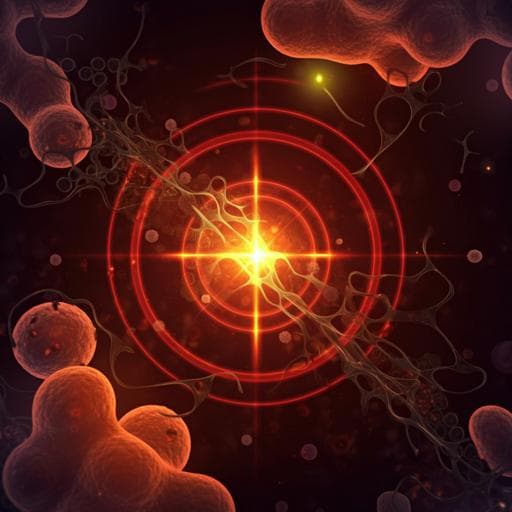
Medicine and Health
A neutrophil mimicking metal-porphyrin-based nanodevice loaded with porcine pancreatic elastase for cancer therapy
T. Cui, Y. Zhang, et al.
Discover an innovative tumor discrimination nanodevice inspired by neutrophils, designed for precise cancer cell elimination regardless of antigen recognition. This groundbreaking research by Tingting Cui, Yu Zhang, Geng Qin, Yue Wei, Jie Yang, Ying Huang, Jinsong Ren, and Xiaogang Qu showcases a selective and effective approach to combating solid tumors, demonstrating promising in vivo results in tumor growth inhibition and adaptive immune response activation.
~3 min • Beginner • English
Introduction
The study addresses the challenge of precisely discriminating and eradicating tumor cells without relying on antigen recognition, a limitation of many cell-based immunotherapies that face antigen heterogeneity and off-tumor toxicity. Neutrophils, which can target inflammation and eliminate pathogens, have inspired the approach due to reports that neutrophil elastase (ELANE) or porcine pancreatic elastase (PPE) selectively kills diverse cancer cell types while sparing normal cells by a mechanism dependent on elevated histone H1 isoforms. ELANE/PPE proteolytically liberate the CD95 death domain (DD), inducing DNA damage, histone H1 nucleo-cytoplasmic translocation, binding to CD95 DD, mitochondrial co-localization, and apoptosis. However, neutrophil-based therapies are limited by variable phenotypes, low delivery efficiency, and handling complexity. A cell-free biomimetic strategy combining immune cell homing and nanomaterial-controlled release offers a solution. The authors hypothesize that accelerating histone H1 translocation can maximize therapeutic effect, leveraging that DSBs cause histone H1 release and that singlet oxygen can induce DSBs. They design a neutrophil-mimicking nanodevice (FKPN) that selectively unlocks in cancer cells with high GSH to release PPE and a nucleus-targeted porphyrin NLS photosensitizer, enhancing histone H1 translocation and selective cancer killing while inducing systemic antitumor immunity.
Literature Review
Prior work has engineered immune cells (CAR-T, CAR-NK, CAR-macrophages) and cell surface modifications to improve tumor targeting but faces antigen heterogeneity and off-tumor toxicity. Neutrophils and their elastases (ELANE/PPE) have been shown to selectively kill many cancer types via a mechanism dependent on elevated histone H1 isoforms rather than tumor-restricted antigens, suggesting tumor-agnostic potential and mediating abscopal effects through cytotoxic T cells. Clinical development of ELANE/PPE is underway. Neutrophil-based cellular therapies encounter challenges including phenotype variability, lung trapping, and storage complexities. Biomimetic nanotechnology using cell membrane camouflaging, especially neutrophil membranes, can improve targeting, circulation, and controlled release. Histone H1’s role in chromatin protection changes upon DNA double-strand breaks, which release H1 and sensitize DNA to further damage; reactive oxygen species such as singlet oxygen can induce DSBs. These insights motivate combining PPE with a nucleus-targeted singlet oxygen generator in a GSH-responsive nanodevice for selective cancer therapy and immune activation.
Methodology
- Nanodevice construction: Fe-porphyrin MOF synthesized solvothermally (FeCl3·6H2O, H2TCPP, benzoic acid in DMF, 90°C, 5 h). NLS peptide (KRRRRG) grafted to porphyrin carboxyls via EDC/NHS to form FK. PPE was adsorbed onto positively charged FK (FKP) via electrostatic interactions. Neutrophil membranes (NM) derived from LPS-activated BALB/c mouse neutrophils were coated onto FKP by sonication and extrusion to yield FKPN. Controls included FKN (no PPE) and FPN (no NLS).
- Characterization: SEM/TEM, HAADF-STEM with elemental mapping, UV–vis, FTIR, zeta potential, DLS, nitrogen adsorption, TGA, BCA assay for loading, flow cytometry for particle counts, SDS-PAGE and western blot for membrane proteins (L-selectin, CXCR4, β1 integrin). GSH-triggered unlocking assessed by XPS (Fe3+ to Fe2+ transition), TEM morphology, DTNB assay for GSH consumption, fluorescence recovery of porphyrin, Fe2+ release, SOSG for singlet oxygen under 660 nm irradiation.
- Cell studies: Cell lines included human breast cancer (MDA-MB-231), murine breast cancer (4T1), and normal breast epithelia (MCF-10A, HC11). Uptake assessed using FITC-labeled particles by CLSM; targeting validated by blocking CD44 and ICAM-1; uptake mechanisms probed with endocytosis inhibitors and low temperature; lysosomal escape monitored by LysoTracker colocalization. Intracellular ROS detected by DCFH-DA and CLSM/flow under 660 nm laser (0.3 W/cm²). DNA damage evaluated by γH2AX western blot and neutral comet assay. Liberation of CD95 DD assessed by western blot. Histone H1.0 levels checked; histone H1.0 cytoplasmic translocation, CD95 DD-H1.0 interaction and mitochondrial co-localization analyzed by immunofluorescence and co-immunoprecipitation. Selective killing measured by CCK-8 viability, live/dead staining, apoptosis (Annexin V/PI), cPARP and cCASP3 immunostaining. ICD markers HMGB1 (ELISA) and extracellular ATP (bioluminescence assay) quantified.
- In vivo studies: BALB/c mice bearing 4T1 orthotopic tumors used for pharmacokinetics (ICP-MS of blood Fe), biodistribution (in vivo/ex vivo fluorescence), immune activation (flow cytometry of DC maturation in lymph nodes; CD4+/CD8+ T cell infiltration in tumors; effector memory T cells in spleen), therapeutic efficacy (tumor growth, survival, histology H&E, TUNEL, cPARP, cCASP3), and rechallenge for immune memory. Bilateral 4T1 model used to assess abscopal effect after primary tumor treatment with FKPN ± 660 nm irradiation; distal tumor immune infiltration examined (CD4, CD8 IIF). DC and T-cell depletion (anti-CD11c, anti-CD4, anti-CD8a) performed to test dependence of effects. Biosafety assessed via body weight, blood biochemistry/hematology, and organ H&E.
Key Findings
- Construction and loading: FKPN exhibits uniform anisotropic size (~240 nm length, ~95 nm width) and monodispersity; successful NM coating confirmed by zeta potential shift (from +11.7 mV to −16.2 mV) and presence of L-selectin, CXCR4, β1 integrin. PPE loading number per particle ~422; NLS peptide number ~1328; PPE loading efficiency ~10.27%.
- GSH-triggered unlocking: FKPN remains stable in PBS; GSH reduces Fe3+ to Fe2+ (XPS), disintegrates particles within hours, consumes GSH (DTNB), restores porphyrin fluorescence and releases Fe2+ proportionally to GSH. FKPN alone yields negligible 1O2 under irradiation; with GSH (2.5–10 mM), strong SOSG signals indicate retained 1O2 generation in reducing environments.
- Targeting and uptake: NM coating enhances selective uptake by cancer cells (MDA-MB-231, 4T1) over normal (MCF-10A, HC11); ~3× higher uptake vs FKP in MDA-MB-231. Targeting mediated by CD44 and ICAM-1 interactions; blocking reduces uptake ~50%. Internalization is energy- and clathrin-dependent. FKPN escapes lysosomes within 4 h (Pearson colocalization decreases from ~0.79–0.81 to ~0.15–0.18).
- Nuclear targeting and ROS: Porphyrin-NLS improves nuclear localization (FKPN/FKN > FPN). Under 660 nm irradiation, cancer cells show elevated intracellular and nuclear ROS; normal cells do not.
- Mechanism: FKPN in cancer cells promotes CD95 DD liberation (vs FKN), increases γH2AX phosphorylation and comet tail lengths under irradiation, indicating enhanced DSBs. FKPN plus irradiation drives cytoplasmic histone H1.0 translocation and strong CD95 DD–H1.0 interactions with mitochondrial co-localization in cancer cells (not in normal), confirmed by immunofluorescence and co-IP.
- In vitro efficacy and ICD: With irradiation, FKPN induces ~95.8% (MDA-MB-231) and ~94.8% (4T1) cancer cell death by 48 h, with negligible effects on MCF-10A/HC11. Increased apoptosis (Annexin V/PI, cPARP, cCASP3). ICD hallmarks elevated: HMGB1 release and ATP secretion significantly increased in cancer cells upon FKPN + laser.
- Pharmacokinetics and targeting in vivo: NM camouflage prolongs circulation half-life: FKPN t1/2 ~4.98 h (vs FKP 1.43 h; FPN 4.06 h; FKN 4.51 h). Strong tumor accumulation and sustained fluorescence up to 72 h; >12-fold tumor accumulation for NM-coated vs uncoated.
- Immune activation in vivo: After FKPN + irradiation, DC maturation in lymph nodes reaches ~60.0% CD80+CD86+. Elevated tumor-infiltrating CD8+ T cells and CD4+ T cells (CD4+ up to 48.2%). Effector memory T cells (CD44+CD62L−) increased in spleen.
- Therapeutic efficacy: FKPN + irradiation eradicates tumors in 50% of mice, yields highest survival benefit, induces strong TUNEL, cPARP, cCASP3 signals in tumors. Rechallenge shows significant protection vs naïve controls, indicating immune memory.
- Abscopal effect: Treating primary tumors with FKPN + irradiation suppresses untreated distant 4T1 tumors by ~90% vs PBS controls; increases CD4+ and CD8+ T-cell infiltration in distal tumors; induces apoptosis/necrosis in both primary and distal sites. Abscopal effect is tumor-specific (no effect on unrelated B16F10 distal tumors). DC or T-cell depletion attenuates primary control and abolishes abscopal effect, confirming dependence on DCs and T cells.
- Biosafety: No significant weight loss, normal blood parameters, and no major organ histopathology abnormalities observed.
Discussion
The work demonstrates a neutrophil-mimicking, antigen-agnostic nanodevice that achieves precise tumor discrimination and eradication by exploiting cancer-specific elevation of histone H1 isoforms and intracellular redox conditions. GSH-responsive unlocking in cancer cells releases PPE to proteolytically liberate CD95 DD and a nucleus-targeted porphyrin that generates singlet oxygen under 660 nm irradiation. The resultant DNA DSBs amplify histone H1 nucleo-cytoplasmic translocation, increasing CD95 DD–H1.0 interactions and mitochondrial apoptosis specifically in cancer cells. This dual mechanism couples selective cytotoxicity with robust induction of immunogenic cell death, driving DC maturation, T-cell activation, and memory formation. In vivo, FKPN enhances tumor accumulation, prolongs circulation, eliminates primary tumors, and elicits a T cell–dependent abscopal effect, indicating potential for systemic control of disease while minimizing off-target toxicity. These findings address the limitations of antigen-dependent therapies and neutrophil-based cellular strategies by providing a controllable, cell-free platform with broad tumor selectivity.
Conclusion
The study introduces FKPN, a neutrophil membrane-camouflaged, GSH-responsive Fe-porphyrin MOF nanodevice co-delivering PPE and a nucleus-targeted porphyrin photosensitizer, to achieve antigen-independent, selective cancer therapy. By integrating PPE-mediated CD95 DD liberation with nuclear singlet oxygen-induced DSBs, FKPN amplifies histone H1 translocation and triggers mitochondria-dependent apoptosis selectively in cancer cells, while inducing strong ICD and adaptive antitumor immunity. In vivo, FKPN exhibits favorable pharmacokinetics, tumor targeting, primary tumor eradication in half of treated mice, immune memory upon rechallenge, and a pronounced, T cell– and DC-dependent abscopal effect with minimal toxicity. Given ongoing clinical development of PPE, this biomimetic strategy offers a promising pathway toward clinical translation for solid tumor therapy.
Limitations
Related Publications
Explore these studies to deepen your understanding of the subject.







